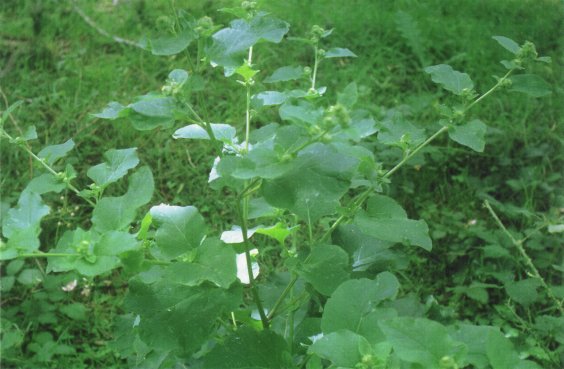|
 An
Illustrated Guide to An
Illustrated Guide to
Common Weeds
of New Zealand
Arctium
minus
burdock
Family
ASTERACEAE
Reproduced from
Common
Weeds of New Zealand
by Ian Popay, Paul Champion & Trevor James
ISBN 0 473 09760 5
by kind permission of the
New
Zealand Plant Protection Society
Publication or other use of images or descriptive
text on these pages is unauthorised unless written permission is
obtained from the authors and publisher.
Appropriate acknowledgement
of the publication Common Weeds of New Zealand must always
be given.
Available from Nationwide Book Distributors
Upright, open-branched,
shrubby perennial up to 1.5 m tall with large leaves and a large,
egg-shaped flower head surrounded by hooks that cling to clothes
or wool.
- Flowers
Flower head thistle-like, reddish-purple, egg-shaped, up to 2
x 3 cm. The bracts surrounding the flower head carry hooks that
cling to clothes and wool. Flowers Jan-Apr.
- Fruit
The 5-7 mm long achenes (seeds), with pappus ('thistle-down')
up to 3.5 mm long, remain in the bur-like seed heads until they
are caught on animals or clothing.
- Leaves
Hollow-stalked, triangular basal leaves up to 40 cm long by 30
cm wide. Green and sparsely hairy on the upper surface, white
and densely downy underneath. Base of leaves heart-shaped.
- Stems
Sparsely to densely hairy, rarely hairless or mealy, grooved.
Habitat
Forest margins, scrub,
creek beds, pasture, sheep-yards, gardens and waste places.
Distribution
Occasional throughout
NI and SI except for Westland. Originally from Europe and west
Asia.
Comments
Young, cooked flowering
stems can be used as a vegetable, and the small green shoots of
young plants can be eaten. Burdock root has a reputation as a
general herbal remedy. Subject to Pest Plant Management Strategies
in several regions of NZ. Details are available from individual
regional councils or unitary authorities.
Related
and similar species
Arctium lappa,
with larger, longer-stalked flowers and solid stalked lower leaves,
occurs in similar habitats, restricted to Morrinsville in the
Waikato and found in scattered sites in Canterbury and Otago.
In Japan, the roots are used as a vegetable (gobo). Winter heliotrope
(Petasites fragrans) has large basal leaves, but these
are kidney-shaped, and its flower heads are similar to burdock
but do not form burs. It occurs in waste places, along stream-sides
and under trees, usually in wet areas, mostly in southern SI,
but also in Palmerston North and Auckland.
Derivation
of botanical name
Arctium (Gr.)
= mullein; minus (Lat.) = smaller.

Web-notes:
Weed Links
On this site
Reproduced from Common Weeds
of New Zealand:
External Links
 Weedbusters
New Zealand Weedbusters
New Zealand
- Weedbusters is a weeds awareness and education programme that aims to
protect New Zealand's environment from the increasing weed problem.
- AgPest
- A free tool to assist farmers and agricultural professionals in decision-making regarding weed and pest identification, biology, impact and management.
 New Zealand Weeds Key New Zealand Weeds Key
- An interactive identification key to the weeds of New Zealand. Developed at Landcare Research.
New
Zealand Plant Conservation Network naturalised plants
- Search for information on more than 2500 naturalised and weedy plants.
 New
Zealand Plant Protection Society New
Zealand Plant Protection Society
- Their main objective: "To pool and exchange information on the biology
of weeds, invertebrate and vertebrate pests, pathogens and beneficial organisms
and methods for modifying their effects."
-
 Massey
University Weeds Database Massey
University Weeds Database- A site providing information about New Zealand weeds and weed control.
It has a series of pages showing pictures of New Zealand weeds, notes on
identification and control. It also provides information on a university
paper entitled Controlling Weeds.
-
-
More
Plant Profiles
|







